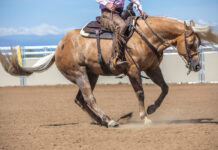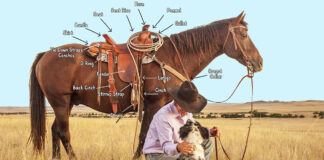Q: I recently got a new saddle and, unlike my old one, it has a back cinch. When I fastened it, my horse started bucking. I stopped him as quickly as I could and eventually got him to canter without bucking while I longed him. However, when I saddled him up the next day, he started bucking again. How can I help him get accustomed to the back cinch?
Next time, rather than stopping your horse when he bucks, let him move his feet and get used to wearing the back cinch. When I saddle a horse for the first time, I practice longeing for respect, an exercise that allows me to stay a safe distance from the horse but still control his feet. If your horse is going to buck, you want him to buck as hard as he possibly can. He needs to realize that he’s not going to get rid of the cinch or the pressure around his flank.
After your first groundwork session, let your horse wear the saddle all day by turning him loose in a safe area where he has plenty of room to move his feet. A safely enclosed arena would be ideal. You want him to think that the saddle is just another part of him—like his mane or tail—and no matter what he does, he’s not going to get rid of it. The important thing is not to take the saddle off until he is completely comfortable with it.
The next time you saddle your horse, and each time after that, he’s not allowed to buck. Continue practicing longeing for respect, but any time he tries to buck, immediately redirect his feet by yielding his hindquarters and send him off in a new direction. To get your horse to yield his hindquarters, first switch hand positions with the longeline and the training stick or whip. Then, slide your hand down the length of the longeline, take one big step out to the side and in front of your horse’s drive line, blocking his path, and point with your finger up high in the new direction you want him to go. If he doesn’t immediately pick up his front end and pivot on his hind feet to move through the turn and go out on the circle, take a big step toward him while you swing the stick toward his head and neck. As soon as he moves his front end away from you to go out on the circle, let the longeline slide through your hand so he has somewhere to go.
When you redirect your horse’s feet, do it with a lot of hustle; make it clear that his behavior is unacceptable. The more often you make your horse stop and change directions, the more he’ll start paying attention to you and stop thinking about the back cinch. That’s why it’s important that you be able to safely control your horse on the ground first. As long as you can control his feet, you’ll keep yourself safe and be able to stop any unwanted behaviors, such as bucking.
Never let a horse get into the habit of bucking every time you tack him up. Remember, horses are creatures of habit. The first time you do something with a horse, you plant a seed in his mind. If you do it again, it becomes a habit. The third time, it becomes an ingrained habit.
Continue to practice groundwork exercises until your horse is moving calmly around you and is using the thinking side of his brain. You never want to end a training session on a bad note. The first day you try some groundwork with him, it might take 30 minutes before he relaxes and starts to pay attention to you. On the second day, it may take only 20 minutes before he calms down and uses the thinking side of his brain. Continue to chip away at it every day until your horse is relaxed and listening to you as soon as you begin groundwork. Then you’ll know he’s comfortable with the back cinch, and you can safely ride him.
Clinician Clinton Anderson owns and operates Downunder Horsemanship in Stephenville, Texas, where his method of horsemanship has helped to transform the relationship between thousands of horses and riders. He also hosts two training programs that air weekly on Fox Sports Net and RFD-TV. www.downunderhorsemanship.com
This article originally appeared in the June 2011 issue of Horse Illustrated. Click here to subscribe.






Good to remember.
Article worth rereading.
great article
I love Clinton Anderson!!!!! <3 Went to a couple of his clinics once. 🙂
m
t